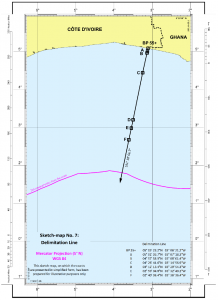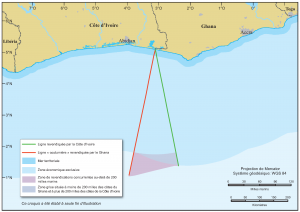The Ghana versus Cote d’Ivoire maritime boundary dispute reached its final conclusion on Saturday 23 September 2017 when the Special Chamber (SC) of the International Tribunal for Law of the Sea (ITLOS) delivered its judgment.

The final maritime boundary (from the judgment )
The 'Customary Boundary' and oil discoveries
Ghana argued that there was a de facto boundary that had been observed by both States since the 1950s, evidenced by long-standing alignment of oil licence blocks. This ‘customary boundary’ was based on equidistance and extended as a straight line in a SSW direction. Shortly after Tullow Oil (Ghana) discovered the TEN fields that lie about 30M offshore close to this boundary in 2011, Cote d’Ivoire submitted its new claim to a maritime boundary lying east of the fields and issued a triangular zone of new oil licences.
What the two States wanted
Ghana’s submission was that the boundary should follow the customary line or, in the event that this was rejected by the SC, the provisional equidistance line should be adjusted to match the customary line.
Cote d’Ivoire cited the concavity and instability of its coast, the convexity of the Ghanaian coast, and the regional orientation that trended north of east. Its submission was a bisector line extending in a SSE direction thus forming a triangular area of overlapping claims.

The claim lines of the two States
The judgment of the Chamber
The SC rejected all Ghana’s submissions for the customary line based on tacit agreement saying that there had never been any agreement over the boundary. It also rejected Cote d’Ivoire’s arguments for the use of a bisector, saying that both Parties managed to draw an equidistance line without difficulty. It drew the boundary based on first principles – the now standard three-stage process of drawing a provisional equidistance line, adjusting it in the light of relevant circumstances, and finally checking that the final line does cause any great disproportion between the ratio of the coasts and the ratios of the allocated areas.
Defining the maritime boundary
After drawing the equidistance line the SC decided there were no relevant circumstances that would call for an adjustment of the line, and also that the line as drawn did not produce any significant disproportionality. As a result the final boundary is (unusually) an unmodified equidistance line.
The final line drawn by the SC matches very closely the customary equidistance boundary proposed by Ghana.
Claims for reparation rejected
The SC also rejected the claims that Ghana had violated the sovereign rights of Cote d’Ivoire, and rejected the claims that Ghana had violated the new drilling ban put in place in 2015 so as not to exacerbate the dispute.
Drilling can continue
Tullow Oil welcomed the judgment and will now restart the development drilling to increase production from the TEN fields to the target of 80,000 bopd.
Tullow press release: http://www.tullowoil.com/media/press-releases/itlos-judgment
Details of the case: https://www.itlos.org/cases/list-of-cases/case-no-23/